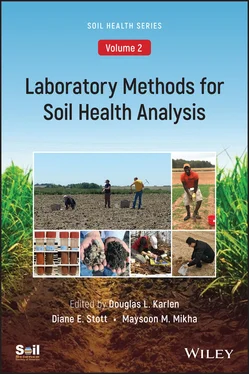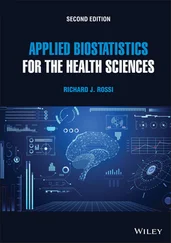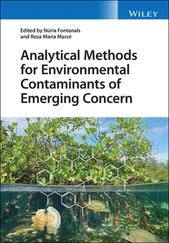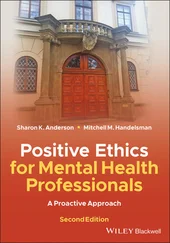Laboratory Methods for Soil Health Analysis, Volume 2
Здесь есть возможность читать онлайн «Laboratory Methods for Soil Health Analysis, Volume 2» — ознакомительный отрывок электронной книги совершенно бесплатно, а после прочтения отрывка купить полную версию. В некоторых случаях можно слушать аудио, скачать через торрент в формате fb2 и присутствует краткое содержание. Жанр: unrecognised, на английском языке. Описание произведения, (предисловие) а так же отзывы посетителей доступны на портале библиотеки ЛибКат.
- Название:Laboratory Methods for Soil Health Analysis, Volume 2
- Автор:
- Жанр:
- Год:неизвестен
- ISBN:нет данных
- Рейтинг книги:3 / 5. Голосов: 1
-
Избранное:Добавить в избранное
- Отзывы:
-
Ваша оценка:
- 60
- 1
- 2
- 3
- 4
- 5
Laboratory Methods for Soil Health Analysis, Volume 2: краткое содержание, описание и аннотация
Предлагаем к чтению аннотацию, описание, краткое содержание или предисловие (зависит от того, что написал сам автор книги «Laboratory Methods for Soil Health Analysis, Volume 2»). Если вы не нашли необходимую информацию о книге — напишите в комментариях, мы постараемся отыскать её.
Analyzing, comparing, and understanding soil health data Soil Health, Volume Two: Laboratory Methods for Soil Health Analysis
Laboratory Methods for Soil Health Analysis, Volume 2 — читать онлайн ознакомительный отрывок
Ниже представлен текст книги, разбитый по страницам. Система сохранения места последней прочитанной страницы, позволяет с удобством читать онлайн бесплатно книгу «Laboratory Methods for Soil Health Analysis, Volume 2», без необходимости каждый раз заново искать на чём Вы остановились. Поставьте закладку, и сможете в любой момент перейти на страницу, на которой закончили чтение.
Интервал:
Закладка:
Color– A healthy soil’s dark brown color indicates the presence of a lot of carbon in the form of decomposed organic matter. In contrast, gray, yellow, or mottled colors indicate soil that has a low carbon content, is poorly drained and poorly aerated, and likely low in nutrients available to plants.
Crumbs– A soil that is crumbly, like coffee grounds or cake crumbs, and holds that aggregate structure is likely in good physical condition supporting soil health. This is structure that allows water movement yet aeration, as well as root penetration. It holds up even when the soil is wet. If the dry soil can easily be ground to dust between the fingers, or it turns into a slick film when wet and rubbed between the forefinger and thumb, the aggregates are not stable and will not support a good crop.
Critters– A healthy soil shows lots of evidence of life. Pulling the crop debris back from the surface should reveal earthworms, or their holes and castings. Turning over the soil with a shovel should uncover insects, pillbugs, and other arthropods essential in carbon and nutrient cycling. A low‐power hand lens might allow observation of smaller arthropods such as mites that feed on debris and microbes, and perhaps even the filamentous hyphae of fungi or the near‐microscopic worms that feed on them. A soil that lacks evidence of diverse life is not healthy.
Cooperation, with roots, that is– A healthy soil does not constrain roots, its structure allows plant roots to grow vertically and laterally. When roots look stunted or turn at odd angles, it is likely that the soil is compacted or has a plow layer that obstructs root growth because it lacks good structure and aeration for a crop. Stubby, deformed, discolored, or rotten roots can also indicate the presence of parasitic nematodes, plant‐feeding insect pests, or pathogenic microbes in the soil, none of which is desirable for a healthy soil.
Cologne– A healthy soil has a fragrant, earthy aroma, indicative of the many aerated biological processes happening. A soil that has a sour or rotten‐egg odor is poorly aerated, probably because of poor structure and poor drainage, and is not likely to be a hospitable environment conducive to plant root development or beneficial microbes.
What Do Researchers Need, and Can They Reach Consensus?
The Five C’s of Soil Health may be useful to a farmer, and they can use them to consider modifications to production practices that could push the soil toward more desirable characteristics. For research purposes, however, these indicators are insufficiently quantitative, repeatable, and explanatory for statistical analyses and hypothesis testing about soils at different locations, under different production systems, or subjected to different management practices. For those needs, measurements that are highly repeatable and based on standardized protocols and techniques within research laboratories are needed.
At this other extreme, a new set of challenges arises– how to get a representative sample, how to handle and store it before it can be analyzed, which properties to measure, which measurement method to use, how to report the data, how to develop recommendations from those data. Just as a physician cannot adequately describe the health of a human patient with a small number of measurements or distillation of many measurements into a single number, scientists must rely on multiple different indicator measurements to provide a scientifically meaningful assessment of a soil’s health. Preferences regarding specific measurements to make and methods to use are no doubt numerically equal to the number of scientists wanting to assess soil health. Reaching consensus in the community has been and continues to be a difficult task.
Currently, there are two integrated and coordinated efforts to identify suitable soil health indicator measurement protocols and to assess their utility throughout the country. One, led by the U.S. Department of Agriculture– Natural Resources Conservation Service (USDA‐NRCS) Soil Health Division (SHD), is Soil Health Technical Note No. 450–03 (Stott, 2019) entitled “Standard Indicators and Laboratory Procedures to Assess Soil Health.” The other is a research project led by the Soil Health Institute (SHI), which is evaluating the utility of analytical methods to determine the usefulness of over 30 soil health indicators across much of North America. Methods addressed in this volume are applicable to both efforts and reinforce the concept that data on physical, chemical, and biological properties and processes all must be obtained for a full understanding of a soil’s health.
Both the SHI and NRCS‐SHD efforts obtained input from researchers, farmers, soil‐testing laboratories, non‐governmental organizations (NGOs), and representatives of state and federal agencies starting in 2013, when the two longest‐serving agricultural foundations in the United States (Farm Foundation, established 1933; and The Samuel Roberts Noble Foundation, established 1945) partnered to design and initiate the Soil Renaissance effort. Several workshops were organized and facilitated to identify and strive for consensus regarding appropriate indicators of soil health. Each workshop was attended by a different mixture of university, government, and private industry scientists, field conservationists, and farmers. Technical discussion papers were written by teams of scientists from the U.S. Department of Agriculture and land‐grant universities. Between 2014 and 2016, many measurement‐related issues and challenges were assessed, including the status of existing soil health measurement frameworks; the benefits of a “tiered” approach for measurements at different stages of development and reliability; service lab adoption issues; data needs; communications plans; data interpretation, including issues related to different regions; sampling protocols; sample archives; quality assurance/quality control (QA/QC) protocols; and sampling frequency. To further the vision of the Soil Renaissance and implement its findings, the Soil Health Institute was created in 2015. In June 2017, the SHI used input from the Soil Renaissance effort to conduct a survey of 179 individuals who were active in the measurement‐related workshops organized by the SHI and/or the Soil Renaissance over the three years. A consensus emerged among the 48 respondents that many of the measurements used to characterize soil conditions for many years are also valuable for assessing soil health. These measurements– physical and chemical, supplemented with a few key biological– are well‐accepted in the scientific community and thus were designated by the Soil Renaissance participants as “Tier 1” indicators. They can be used directly or as ancillary factors needed to improve the interpretation of yet other measurements. They include:
Physical:Soil textureWater‐stable aggregationBulk densityWater penetration resistanceVisual rating of erosionInfiltrationAvailable water holding capacity
Chemical:Routine inorganic chemical analysis (N, P, K, micronutrients, pH, cation exchange capacity, base saturation, electrical conductivity)Soil organic carbon
Biological:Short‐term carbon mineralization (respiration)Nitrogen mineralizationCrop yield
The Soil Renaissance, SHI, and NRCS‐SHD communities also identified a group of measurements that have been designated “Tier 2”, mostly biological properties or processes in soil, for which there is scientific consensus that they are related to soil health but are less standardized with regard to measurement methods, interpretation, and known thresholds for management action. These indicators are identified in the SHI Action Plan ( www.soilhealthinstitute.org, accessed February 20, 2020) as targets for research to develop sufficient response data to complete their development as reliable measurements. To achieve those goals, the Tier 2 indicators listed below need further development, testing, and evaluation on working farms so they can eventually be transferred and communicated to landowners, operators, and retailers as tools for improving soil and crop management practices. They include:
Читать дальшеИнтервал:
Закладка:
Похожие книги на «Laboratory Methods for Soil Health Analysis, Volume 2»
Представляем Вашему вниманию похожие книги на «Laboratory Methods for Soil Health Analysis, Volume 2» списком для выбора. Мы отобрали схожую по названию и смыслу литературу в надежде предоставить читателям больше вариантов отыскать новые, интересные, ещё непрочитанные произведения.
Обсуждение, отзывы о книге «Laboratory Methods for Soil Health Analysis, Volume 2» и просто собственные мнения читателей. Оставьте ваши комментарии, напишите, что Вы думаете о произведении, его смысле или главных героях. Укажите что конкретно понравилось, а что нет, и почему Вы так считаете.












